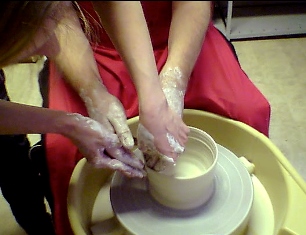Making sense. What can we learn from experts of tactile knowledge?
DOI:
https://doi.org/10.7577/formakademisk.656Emneord (Nøkkelord):
tactility, embodied knowing, making, clay, deafblindSammendrag
This article describes an embodied way of making sense through making with the hands. We examine the potential o ftactile experience in the making process and analyse what tactile experiences mean. The study takes place in the context of an era marked by audio-visual dominance.The article presents a case study that observed and interviewed deafblind makers while they worked with clay. The findings reveal that modelling in clay resembles the visualisation process of sketching. As such, it may contribute to thinking through the hands. Language is not a self-evident communication tool for transferring tactile skills. Based on our case study, we propose the use of tactile communication in the process of transferring tactile knowledge through making with another person’s hands.
Nedlastinger
Publisert
2013-09-21
Hvordan referere
Groth, C., Mäkelä, M., & Seitamaa-Hakkarainen, P. (2013). Making sense. What can we learn from experts of tactile knowledge?. FormAkademisk, 6(2). https://doi.org/10.7577/formakademisk.656
Utgave
Seksjon
Inviterte Artikler
Lisens
- Forfatteren(e) beholder sin opphavs- og kopieringsrett til eget manuskript, men gir tidsskriftet varig rett til 1) å fremføre manuskriptet for offentligheten i den opprinnelig publiserte digitale form, og 2) å registreres og siteres som første publisering av manuskriptet.
- Forfatteren må selv forvalte sine økonomiske kopieringsrettigheter overfor eventuell tredjepart.
- Tidsskriftet gir ingen økonomisk eller annen kompensasjon for innsendte bidrag, medmindre det er gjort særskilt avtale om dette med forfatteren(e).
- Tidsskriftet plikter å arkivere manuskriptet (inklusive metadata) i den opprinnelig publiserte digitale form, i minst ett dertil egnet åpent tilgjengelig langtidsarkiv for digitalt materiell, som for eksempel i de norske universitetenes institusjonsarkiv innen rammen av NORA-samarbeidet.
- Lesere av tidsskriftet kan ta utskrift av de fremførte manuskriptene under samme betingelser som gjelder ved kopiering av fysiske eksemplar. Dette innebærer at masseframstilling av fysiske eksemplar, eller framstilling av eksemplar for kommersielle formål, ikke er tillatt uten etter avtale med forfatteren(e).



